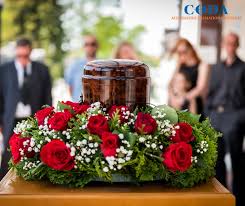(Pictured: Traditional burial methods, such as cremation, are being passed over by consumers who choose non-traditional methods.)
Since time immemorial, contemplating one’s own funeral has been an awkward yet unavoidable aspect of life. Traditionally, the decision seemed straightforward: Burial or cremation. But as society’s values shift, so, too, do the ways we consider our post-mortem journey.
The trend toward environmentally conscious funeral options is on the rise as awareness spreads. Choice Mutual, a Reno, Nev.-based company that specializes in funeral insurance for seniors in the U.S., surveyed 6,000 people to gauge preferences for non-traditional burial methods. The findings were revealing, highlighting a growing interest in eco-friendly funeral alternatives.
- The most popular option among Americans was Green Burials. This method skips the embalming process and uses biodegradable caskets or shrouds. The aim is to allow the body to decompose naturally and return to the earth without harming the environment.
- In second place came Natural Organic Reduction (Human Composting). This method involves placing the body in a special vessel with organic materials like wood chips and straw. Over several weeks, the body decomposes naturally, turning into nutrient-rich soil.
- A surprising choice emerged as the third-most popular: Tree Pod Burials. The body is placed in a biodegradable pod that is then buried in the ground. A tree is planted above the pod, and as the body decomposes, it nourishes the tree
- Memorial Reefs was the fourth-most popular pick. This involves creating artificial coral reefs using remains mixed into an environmentally safe cement. These reefs provide habitats for marine life and help restore endangered coral ecosystems. An alternative approach is to create a reef ball from the cremated remains
- In fifth place was Mushroom Suits–a biodegradable burial suit or shroud embedded with mushroom spores. The mushrooms decompose the body and neutralize toxins that are released during decomposition.
- Aquamation (Alkaline Hydrolysis) was the sixth-most sought after method. Also known as water cremation, this process uses water and lye to break down the body. It’s more eco-friendly than traditional cremation since it uses less energy and releases fewer emissions.
- Space Burials, which came in sevnth, is an avant-garde choice that involves sending ashes into orbit. There are environmental concerns about space debris.
With personal debt in America soaring, 45% cite the high costs associated with traditional funerals — typically between $7,000 and $12,000 — as the major concern. These expenses often cover a range of services, including casket purchase, service fees, burial vault, and costs for the gravesite and its preparation, not to mention headstones and funeral ceremonies.
Regarding funeral funding, life insurance is expected to cover the costs for 39% of respondents. Personal savings are the anticipated source for 29%, while 11% may rely on family contributions. A small fraction, 3%, even consider crowdfunding as an option.
